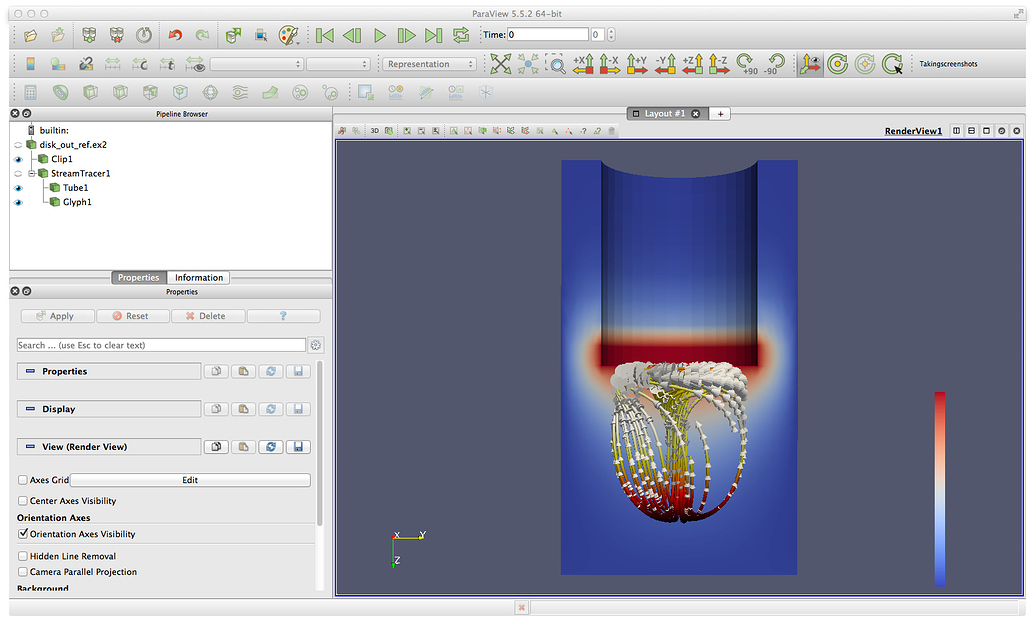

Thus, if you change theĪctive tab, the active view will also be changed to be a view in the active tab The active view is always present in the active tab. You can close a tab, which will destroy all views laid out To create new tabs, use theīutton in the tab bar. Paraview also supports placing views in multiple layouts under Only one view can be active at any timeīesides being able to create multiple views and laying them out in a pane, UI by a blue border around the view frame. Status of the pipeline module in the active view. Similarly, the eyeball icons in the Pipeline Browser show the visibility Reflects the display properties of the active source in the active view. Theĭisplay properties section on the Properties panel, for example, Several panels, toolbars, and menus will update based on the active view. Similar to the notion of active source, there is a notion of active This will swap the positions of the two views. You can move views by clicking and dragging the title bar for the view (orĮmpty view frame) and dropping it on the title bar on another view (or empty Simply click on one of those buttons to create a new view of On splitting a view, an empty frame with buttons for all known types Vertically or horizontally, based on the button used for the split. Splitting a view splits the view into two equal parts, either View frame using the Split View controls at the top-right corner of the New views can be created by splitting the When paraview starts up, the Render View is createdĪnd shown in the application window by default. Paraview shows all views in the central part of the application Shown in a single 3D render view, including line plots! 4.1.1. Multiple views were first supported in ParaView 3.0. In this section, we look at how you can create multiple With multiple types of views comes the need for creating and viewing multiple 4.1 Using multiple views in paraview to generate different types of visualizations from a dataset. In this chapter, we take a close look at the various views available in ParaViewĪnd how to use these views for displaying data.

Comparative variants of Render View and several types of the Chart Views are available in ParaView. These include views such as line charts ( Line Chart View ), bar charts ( Bar Chart View ), bag charts ( Bag Chart View ), parallel coordinates ( Parallel Coordinates View ), etc.Ĭomparative Views are used to quickly generate side-by-side views for parameter study, i.e., to visualize the effects of parameter changes. Other Render View-based views, such as Slice View and Quad View, extend the basic render view to add the ability to add mechanisms to easily inspect slices or generate orthogonal views.Ĭhart Views cover a wide array of graphs and plots used for visualizing non-geometric data. Rendering Views are views that render geometries or volumes in a graphical context. Views often provide mechanisms to save the results as images or in other formatsĭifferent types of views provide different ways of visualizing data. Modules such as filters to process the results in a view). Section 1.2, views are sinks that take in input dataīut do not produce any data output (i.e., one cannot connect other pipeline Referring back to the visualization pipeline from Relevant information can be represented in these views. The role of the visualization pipeline is often to transform the data so that Views provide the canvas on which to display such visual representations,Īs well as to dictate how these representations are generated from the raw data. The visual representations are shown in modules called views. The goal of any visualization process is to produce visual representations of Hope that helps - I’m curious to hear what works best for your use case. That’s why the client-side rendering is preferred in general, although there will be limits on how much data can be downloaded efficiently and how much can be loaded into the browser. This actually works quite nicely, but it means you have to maintain a server with the user’s data loaded or create one on the fly. OHIF client for dicom study browser, layout, app contextįor server-side rendering with Slicer, I’ve been playing for a while with embedding a web server in Slicer.DICOMweb serving all the data (can come from Google Healthcare or self-hosted open source server).Maybe you could describe a bit about what you want to achieve and why your current approach isn’t working for you and why you want to change direction?įor myself, we’ve been working mostly lately with this formulation (all should be easy to find by searching but let me know if you want more info): I’m not personally too familiar with the paraview approaches. Sounds like you are exploring all the good options, but probably there isn’t yet a really complete end-to-end implementation that’s in production.


 0 kommentar(er)
0 kommentar(er)
